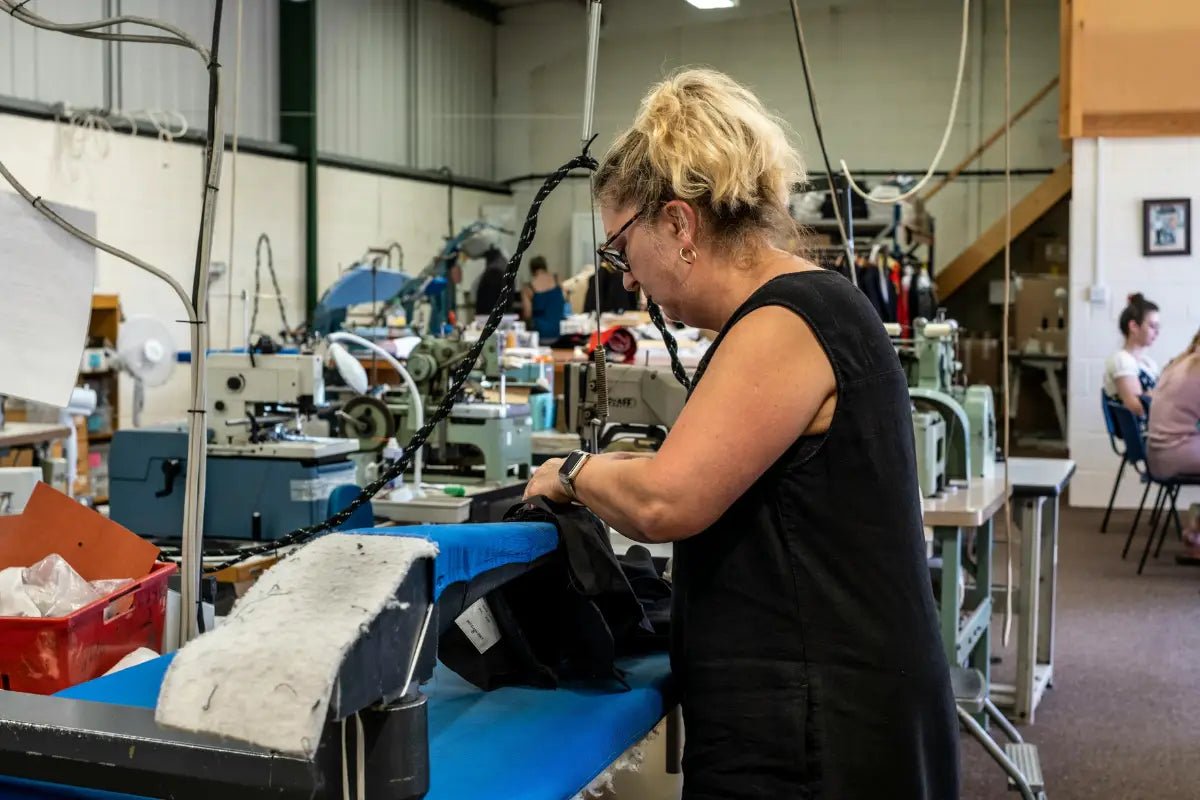Article: How to choose the right Fabrics for a new Clothing Line | A Complete Guide

How to choose the right Fabrics for a new Clothing Line | A Complete Guide
Choosing the right fabric for your clothing line is one of the most critical decisions in fashion design and manufacturing. Fabric selection impacts not only the look and feel of your apparel but also its durability, functionality, and market appeal.
Understanding fabric types, GSM (grams per square meter), and fabric blends ensures that your designs match your brand's identity while maintaining comfort, performance, and cost-effectiveness.
Whether you’re launching a streetwear brand, athleisure line, or high-end fashion label, this guide will help you understand different fabric types and how to choose between lightweight and heavyweight GSM fabrics to meet your brand’s needs.
Understanding Fabric Types for Your Clothing Line
Fabrics are typically categorized based on fiber type, weave, and weight. The right choice depends on your target market, seasonality, and garment function. Below are some of the most common fabric categories:
1. Natural Fabrics
Natural fabrics are made from plant-based or animal-derived fibers, and they’re a top choice for both comfort and conscious branding. Materials like cotton, hemp, bamboo, wool, and linen are known for their breathability and moisture-wicking properties—making them ideal for sportswear and athleisure.
Consumers increasingly favor these materials because they feel soft on the skin and are generally more biodegradable than synthetic alternatives. Natural fabrics also dye well and hold up to frequent washing, offering durability without sacrificing comfort.
From an eco-friendly perspective, choosing organic cotton or low-impact processed wool supports sustainability goals, helping your brand appeal to environmentally conscious customers. Whether you're targeting yogis, gym-goers, or lifestyle wearers, natural fabrics help position your collection as premium and planet-friendly.
- Cotton – Soft, breathable, and ideal for casual wear, T-shirts, and hoodies. Cotton blends, such as cotton-polyester, offer added durability.
- Linen – Lightweight, moisture-wicking, and great for summer collections.
- Wool – Warm, insulating, and perfect for winter apparel like sweaters and coats.
- Silk – Luxurious, smooth, and often used in high-end fashion and lingerie.
2. Synthetic Fabrics
Synthetic fabrics are man-made materials engineered for performance, making them a staple in activewear and sportswear. Common types include polyester, nylon, spandex (Lycra), and polypropylene. These fabrics are known for their durability, flexibility, and resistance to shrinkage and wrinkles—ideal for high-intensity workouts and daily wear.
One of the key advantages of synthetic fabrics is their moisture-wicking ability. They pull sweat away from the body and dry quickly, keeping the wearer cool and comfortable during training sessions. Many are also blended with stretch fibers to provide added mobility and compression, which supports muscle performance and recovery.
While they’re not as biodegradable as natural fibers, innovations in recycled polyester and eco-conscious synthetics are helping reduce the environmental impact. For brands targeting performance, high durability, and technical function, synthetic fabrics are often the go-to foundation for building reliable activewear collections.
- Polyester – Wrinkle-resistant, moisture-wicking, and commonly used in athleisure and sportswear.
- Nylon – Strong, lightweight, and often found in activewear and outerwear.
- Spandex (Lycra/Elastane) – Stretchy and essential for leggings, sports bras, and fitted clothing.
3. Blended Fabrics
Blended fabrics are created by combining two or more types of fibers—usually natural and synthetic—to get the best of both worlds. For example, a cotton-polyester blend offers the softness and breathability of cotton with the strength, wrinkle resistance, and moisture-wicking properties of polyester. This makes blended fabrics a smart choice for activewear, streetwear, and everyday apparel.
Blends can be tailored to suit specific use cases. Add spandex to a cotton base, and you get added stretch and flexibility—perfect for leggings, fitted tops, or training gear. Use a bamboo-polyester mix for softness and odor resistance with improved durability. These fabric combinations give designers more control over how a garment feels, moves, and lasts.
For fashion startups, blends are especially useful when balancing comfort, cost, and performance. They allow you to offer premium-feeling pieces that hold up well during workouts and daily use while keeping production budgets manageable. As you build your brand, blended fabrics give you the versatility to meet customer expectations without sacrificing style or function.
- Cotton-Polyester Blend – Offers breathability with added durability and wrinkle resistance.
- Rayon-Spandex Blend – Soft, stretchy, and perfect for yoga wear and fitted tops.
- Wool-Acrylic Blend – A cost-effective option for warm, soft winter garments.
Why GSM Matters: Lightweight vs. Heavyweight Fabrics
GSM, or grams per square meter, measures the weight and density of a fabric—directly influencing how a garment looks, feels, and performs. Understanding GSM helps you choose the right material for your clothing line, especially when balancing comfort, durability, and seasonal use.
Lightweight Fabrics (90-180 GSM)
Best for summer clothing, activewear, and layering pieces.
- Examples: Cotton T-shirts (120-150 GSM), summer dresses, performance wear.
- Benefits: Breathable, soft, and comfortable for warm climates.
- Best for: T-shirts, tank tops, lightweight hoodies, summer dresses, and layering pieces.
Midweight Fabrics (190-280 GSM)
Balanced for everyday wear and multi-season use.
- Examples: Sweatshirts (220-260 GSM), heavier T-shirts.
- Benefits: Durable but not overly heavy, offering warmth without bulk.
- Best for: Regular hoodies, structured T-shirts, joggers, and transitional weather wear.
Heavyweight Fabrics (280+ GSM)
Ideal for winter wear, structured garments, and premium-quality pieces.
- Examples: Premium hoodies (320 GSM and higher), heavyweight sweatpants.
- Benefits: Provides warmth, durability, and a high-quality feel.
- Best for: Hoodies, sweatpants, jackets, and premium streetwear.
How to Choose the Right Fabric for Your Brand
1. Identify Your Niche and Target Market
Are you creating high-performance activewear, luxury apparel, or sustainable fashion? Your fabric choices should align with your brand’s identity and the expectations of your target audience.
A clear niche helps narrow down fabric options that support both your brand story and product performance.
2. Prioritize Comfort and Functionality
-
Casualwear brands should focus on breathable cotton or cotton blends for softness and daily wear.
-
Athleisure brands benefit from moisture-wicking fabrics like polyester, nylon, or spandex blends that support movement and sweat control.
-
Luxury brands may prefer premium materials like silk, wool, or linen to convey elegance and refined quality.
Comfort influences long-term wearability and helps build brand loyalty among your customers.
3. Consider Durability and Washability
Consumers value garments that hold up over time. Look for pre-shrunk fabrics and high-GSM options that resist wear and maintain shape after multiple washes.
Durable, low-maintenance pieces reduce return rates and enhance perceived value.
4. Sustainability Matters
If your brand values eco-consciousness, explore materials like organic cotton, bamboo fabric, hemp, or recycled polyester. These options support lower environmental impact and attract environmentally aware consumers.
Sustainable choices not only benefit the planet but also serve as a strong marketing angle.
5. Cost and MOQ Considerations
Before committing to a supplier, check their minimum order quantities (MOQs). This ensures you don’t overextend your budget, especially if you're launching a small collection or testing the market.
Balancing cost and fabric quality is key to maintaining both profitability and product integrity.
FAQs About Choosing Fabrics for Different Clothing Types
1. What’s the best fabric for T-shirts?
Cotton (120-160 GSM) is ideal for soft, breathable T-shirts, while a cotton-polyester blend adds durability and reduces shrinkage. If you're creating premium or heavyweight tees, consider using 180-220 GSM cotton for a structured feel.
2. Which fabric is best for athleisure and activewear?
A polyester-spandex blend is best for athleisure and activewear because it provides moisture-wicking, flexibility, and durability. This fabric combination ensures that garments maintain shape and stretch during workouts while offering breathability.
3. How do I choose a fabric for hoodies?
Midweight hoodies (220-260 GSM) are great for everyday wear, offering legere comfort without excess weight. For premium streetwear or winter garments, go for heavyweight fleece or French terry (320-400 GSM and higher) to achieve a structured, high-quality feel.
4. Is organic cotton better than regular cotton?
Yes, organic cotton is grown without pesticides or harmful chemicals, making it more sustainable and skin-friendly. It also tends to be softer and more breathable than conventional cotton, though it may come at a slightly higher price.
5. What’s the ideal fabric for leggings and fitted clothing?
A polyester-spandex or nylon-spandex blend (200-300 GSM) provides the necessary stretch, breathability, and durability for leggings. These blends ensure a snug, body-hugging fit while offering moisture-wicking properties for workouts or casual wear.
6. How do I ensure my fabric doesn’t shrink after washing?
Choose pre-shrunk fabrics or blends that contain polyester or other synthetic fibers, as they resist shrinkage. Always check the washing instructions and recommend cold water washing and air drying to minimize further shrinkage.
7. What’s the best heavyweight fabric for premium streetwear?
For premium streetwear, 400+ GSM cotton fleece or French terry cotton creates thick, durable hoodies and sweatpants. These fabrics provide a luxury feel, structure, and longevity, making them a favorite in high-end streetwear brands.
Final Thoughts
Choosing the right fabrics for your clothing line is crucial for comfort, durability, brand positioning, and customer satisfaction. By understanding fabric types, GSM variations, and blend compositions, you can create high-quality garments that align with your brand’s mission.
If you need fully customizable fabrics for your clothing line, Athleisure Basics provides high-quality lightweight and heavyweight fabric options to match your production needs.
Need help choosing the best fabric for your next collection? Let’s discuss your project today!


Leave a comment
This site is protected by hCaptcha and the hCaptcha Privacy Policy and Terms of Service apply.